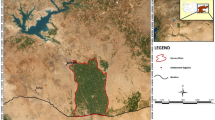Abstract
The Aba’ala spate irrigation systems, traditional and modern, have experienced different set of floodwater and sediment management problems. Despite the dire need of alternative spate irrigation system layout, operational strategy and locally maintainable structures, efforts made to manage floodwater and control sedimentation had been structural. Hence, the study was conducted to evaluate the existing flood and sediment management practices and identify alternative options for optimum management of floods and sediments in Aba’ala plain. Primary data including discharge, sediments and river cross-sections were collected through direct field measurement. Interviews and focal group discussions were also employed to understand the operational and maintenance activities. Delft3D model was used to simulate flow and sedimentation under different scenarios. For the existing condition, the model showed high sediment deposition and low flood water abstraction. The floodwater diverted is 2.1 and 1.16 Mm3 from the traditional intake and 1.52 and 0.51 Mm3 from the modern intake at medium and low floods respectively which is far below the required 2.8 Mm3 of water. Under Scenario-II, the modern intake diversion capacity is improved to 5.38 and 2.36 Mm3 at medium and low floods. However, a water level decline of 15 cm is observed at the downstream traditional intake which could be a cause for conflict between upstream and downstream users. Under Scenario-III, the diversion capacity of the modern intake is increased to 6.23 and 2.67 Mm3 at medium and low floods respectively. Moreover, no decline in water level is shown at the downstream intake.













Similar content being viewed by others
References
Addis A, Dires T, Mitku H Traditional Crop Production Systems in Aba’ala Wereda, North Afar. In: Mitku Haile, Diress Tsegaye, Teka T (eds) Dryland Husbandry in Ethiopia-Research Report, Addis Ababa Ethiopia, December 2001. DHP Publications Series No. 7, OSSREA.
Arcement JGJ, Schneider V (1989) Guide for Selecting Manning’s Roughness Coefficients for Natural Channels and Flood Plains. United States Geological Survey Water-supply Paper 2339. www.pubs.usgs.gov/wsp/2339/report.pdf
CSA (2007) Population and housing census report-afar region. Central Statistical Agency, Addis Ababa
Diress T, Mitiku H, Fikru Y, Lulseged T (2003) Assessment of rangeland condition and livestock mobility pattern in Aba’ala wereda, North Afar: field survey and application of geographic information systems (GIS). Allsopp, AR et al
Kleinhans MG, van Rijn LC (2002) Stochastic prediction of sediment transport in sand-gravel bed rivers. J Hydraul Eng 128:412–425
Mehari A (2007) A tradition in transition: water management reforms and indigenous spate irrigation systems in Eritrea. Taylor & Francis/Balkema, Leiden
Mehari A, Van Steenbergen F, Schultz B (2011) Modernization of spate irrigated agriculture: a new approach. Irrig Drain 60:163–173. doi:10.1002/ird.565
Mehari AH, Demissie A, Embaye TG, Getaneh A (2013) Flood based farming for livelihoods in Ethiopia lowlands - status, potential and investment guide. Agriwaterpedia, Addis Ababa
MoAI (2003) Hydrological Analysis (Second Interim Report). Republic of Yemen Ministry of Agriculture and Irrigation
Pirestani MR, Vosoghifar HR, Jazayeri P (2011) Evaluation of optimum performance of lateral intakes. World Acad Sci Eng Technol 80:369–373
Ribberink JS (1998) Bed-load transport for steady flows and unsteady oscillatory flows. Coast Eng 34:59–82
Steenbergen FV, Lawrence P, Mehari Haile A, Salman M, Faures J (2010) Guidelines on spate irrigation. Irrigation and drainage paper (FAO), vol 65
Tesfai M, Sterk G (2002) Sedimentation rate on spate irrigated fields in Sheeb area, eastern Eritrea. J Arid Environ 50:191–203. doi:10.1006/jare.2001.0862
Woldearegay K (2004) A study of water resource potential of Aba’ala Wereda. In: Diress T, Mitiku H, Teka T (eds) Research and development experience on dryland husbandry in Ethiopia. OSSREA and Mekelle University, Addis Ababa, pp 93–107
Acknowledgment
Special thanks to the Spate Irrigation Network and International Fund for Agricultural Development (IFAD) for funding the study and article preparation.
Author information
Authors and Affiliations
Corresponding author
Rights and permissions
About this article
Cite this article
Gebrehiwot, K.A., Haile, A.M., de Fraiture, C.M.S. et al. Optimizing Flood and Sediment Management of Spate Irrigation in Aba’ala Plains. Water Resour Manage 29, 833–847 (2015). https://doi.org/10.1007/s11269-014-0846-1
Received:
Accepted:
Published:
Issue Date:
DOI: https://doi.org/10.1007/s11269-014-0846-1




